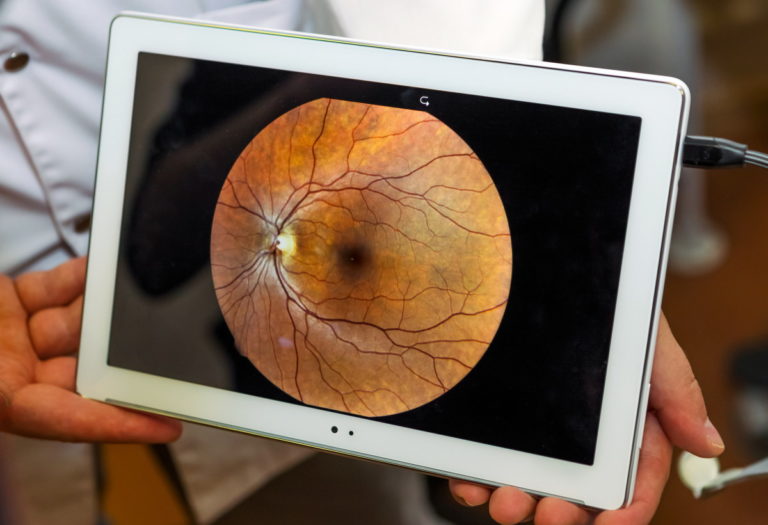
Cataracts
Cataracts are a condition typified by the appearance of cloudy areasin the normally clear lens of the eye. The “lens” is the colored part of the eye centered around the pupil, which is located behind the iris itself. Its job is to focus light on the back of the eye, which sends the images we observe through the optic nerve to the brain. If it becomes clouded, the lens can no longer focus properly.
Signs and symptoms of a cataract may include:
- Blurred or dimmed vision
- Increased sensitivity to glare from lights, especially when driving at night
- Increased difficulty seeing in dim light or dark areas.
Most cataracts are the simple result of age-related changes in the lens. Unfortunately, they can cause significant problems for the patient, especially if not treated properly. Other factors that contribute to the development of cataracts include:
- Extensive exposure to sunlight
- Smoking
- Diabetes
- Certain types of steroid medications
- Previous trauma to the eye, including swelling and surgery
The proper course of treatment for a cataract will depend on how much it is impacting your vision. For instance, if the cataract is not causing significant problems, we may only suggest a series of appointments to monitor the condition. However, once it progresses to the point that it affects your ability to do normal, everyday tasks, we may recommend surgery.
If you are suffering from any of the above symptoms or suspect you may have a cataract, you should immediately schedule an appointment with River City Eyecare.
Glaucoma
The term “Glaucoma” refers to a group of eye conditions that damage the optic nerve over time. It is often related to increased pressure inside the eye and can lead to permanent vision loss if not properly treated. In fact, Glaucoma is the second leading cause of blindness in the United States and the leading cause of blindness in people of Hispanic descent.
Unfortunately, as there are typically no symptoms associated with Glaucoma, many people are unaware they have the condition until after significant vision loss has occurred. That is why River City Eyecare recommends taking a preventative approach through annual Glaucoma checkups.
Certain factors can increase the risk of developing glaucoma. Some of them include:
Family History
Glaucoma has been shown to have genetic markers, increasing the risk for those whose closer relatives have had the disease.
Certain Medical Conditions
Some studies indicate that conditions like diabetes, heart disease, and high blood pressure may increase the risk of developing glaucoma.
Age
People over age 60 are at increased risk for the disease. For people of African American ancestry, that increased risk begins at age 40.
Race
People of African American descent are significantly more likely to get glaucoma. They are also more likely to suffer permanent vision loss. Likewise, people of Asian descent have a higher risk of developing specific types of the disease.
Physical Injuries
Severe trauma, such as being hit in the eye, can cause damage that leads to increases in eye pressure over time. Such injuries can also dislocate the lens, closing of drainable and contributing to pressurization. The same can be said of trauma caused by swelling or surgery, retinal detachment, and eye tumors.
Medications
The over-use of certain steroid-containing medications can also contribute to the development of Glaucoma.
Other Risk Factors
Variations in eye anatomy can make one more or less susceptible to Glaucoma. The most notable examples include the corneal thickness and appearance of the optic nerve. Some studies suggest that suffering from nearsightedness may also contribute to the development of glaucoma.
Though vision already lost to Glaucoma cannot be restored, medication and / or surgery can slow and prevent further vision loss. This is why it is so vital to schedule annual dilated eye examinations with River City Eyecare. In some cases, we may recommend more frequent appointments.
Age-related macular degeneration is the leading cause of severe vision loss in adults over age 50. The condition is the result of the macula, part of the back layer of your eye responsible that allows you to see fine details, begin to deteriorate. Unfortunately, most people exhibit no symptoms in the early stages. However, as the disease progresses, symptoms may begin to appear.
They include the following:
- Blurry vision.
- Dark spots, blank areas, or distortion in your central vision.
- The need for more bright light in order to see up close.
- Noticing that colors seem less bright and vibrant.
- Difficulty seeing when moving from bright light to low light.
- Trouble recognizing people’s faces.
In the early stages of macular degeneration, your River City Eyecare professional may recommend anything from sunglasses, vision age, and special vitamins to medication, laser surgery, and vision rehabilitation. As with many eye conditions, however, any lost vision cannot be restored. That’s why we strongly recommend the following at-risk individuals be examined at least once per year:
- Those age 50 or over.
- Those with a history of macular degeneration or blindness of an unknown cause.
- People who suffer from high blood pressure or abnormal cholesterol levels.
- People who smoke or use tobacco products.
Diagnosing and Treating “Dry Eyes”
Dry eye refers to a condition in which a patient lacks sufficient tears to lubricate and nourish the eye. Of course, tears are necessary for maintaining the health of the eye’s surface and for providing clear, unobstructed vision. With each blink of the eyelids, tears are spread across the front surface of the eye, known as the cornea, washing away foreign matter and reducing the risk of infection.
Dry eye is a common and often chronic problem, particularly in older adults, and is typified by:
Tears are produced by several glands in and around the eyelids. Tear production tends to diminish with age, with various medical conditions, or as a side effect of certain medicines. Environmental conditions such as wind and dry climates can also affect tear volume by increasing tear evaporation. Either way, when the normal amount of tear production is decreased, symptoms of dry eye can develop.
Poor Quality of Tears
Tears are made up of three layers: oil, water, and mucus. Each component plays a role in protecting and nourishing the front surface of the eye. A smooth oil layer helps to prevent evaporation of the water layer, while the mucus layer functions in spreading the tears evenly over the surface of the eye. If any of these three components is not of sufficient quality, a patient can develop dry eyes.
People suffering from dry eyes often experience symptoms of irritated, gritty, or burning eyes. They may also feel frequently feel that something is in their eye or suffer from excess watering and blurred vision. In advanced cases, dry eyes may damage the front surface of the eye and impair vision.
Treatment approaches for dry eyes aim to restore a healthy production of tears, minimizing dryness and discomfort while also maintaining eye health.
What Causes Dry Eyes?
There are a number of reasons why an individual might develop this condition. They include:
Age
Reduced tear production is part of the natural aging process. The majority of people over age 65 experience some symptoms of dry eyes.
Gender
Women are much more likely to develop dry eyes than men. This is largely due to hormonal changes caused by pregnancy, the use of oral contraceptives, and menopause.
Medications
Certain medicines, including antihistamines, decongestants, blood pressure medications, and antidepressants, can reduce the amount of tears produced in the eyes.
Medical Conditions
Persons suffering from rheumatoid arthritis, diabetes, and a variety of thyroid problems are typically far more likely to have symptoms of dry eyes.Problems related to inflammation of the eyelids (blepharitis), inflammation of the surfaces of the eye, or the inward or outward turning of eyelids can also cause dry eyes to develop.
Exposure to smoke, wind, and dry climates can contribute to rapid tear evaporation. Failure to blink regularly, such as when staring at a computer screen for long periods, can also contribute to the drying of the eyes. Other factors include the long-term use of contact lenses and refractive eye surgeries such as LASIK.
Dry eyes can typically be diagnosed with a comprehensive eye examination. During this evaluation, your River City Eyecare professional will place special emphasis on the quantity and quality of your tears. We may also perform one or more of the following:
- Examine the patient’s history to determinethe presence of any general health problems, medications taken, or environmental factors that may be contributing to the dry eye problem.
- Perform an external examination of the eye, including lid structure and blink dynamics.
- Perform an evaluation of the eyelids and cornea using bright light and magnification.
- Measure the quantity and quality of tears for any abnormalities. Special dyes also may be instilled in the eyes to better observe tear flow. This also helps highlight any changes to the outer surface of the eye caused by insufficient tears.
Using the information obtained from testing, your optometrist can determine if you have dry eyes and advise you on one of several courses of treatment.
One of the primary approaches used to manage and treat mild cases of dry eyes is the use of over-the-counter artificial tear solutions. Unfortunately, not all patients respond to this simple treatment. If the condition is more chronic, a different course of action may be recommended.
As we just stated, mild cases of dry eyes can often be managed using over-the-counter artificial tear solutions. These can be used as often as needed to supplement natural tear production. However, preservative-free artificial tear solutions are recommended because they contain fewer additives that could further irritate the eyes.
This refers to keeping natural tears in the eye much longer. This can be done by blocking the tear ducts through which the patient’s tears normally drain. This is accomplished using removable silicone or gel-like plugs. A surgical procedure to permanently close tear ducts can also be used. In either case, the goal is to maximize the effectiveness of the tears the body does manage to produce.
Your doctor may prescribe special eye drops that help to increase the production of tears. They may also recommend you supplement with omega-3 fatty acids, which can contribute to increased tear quality.
In cases where there is inflammation around the surface of the eyes, your eye care professional may recommend prescription eye drops / ointments, warm compresses and lid massage, or eyelid cleaners.
There are a few steps you can take to reduce symptoms of dry eyes at home. They include:
- Remembering to blink regularly when reading or staring at a computer screen for long periods of time.
- Increasing the level of humidity in the air at work and at home.
- Wearing sunglasses outdoors, particularly those with a wrap-around frame design. This can drastically reduce your eyes’ exposure to drying winds and sun.
- Taking nutritional supplements containing essential fatty acids like Omega-3.
- Avoiding dehydration by making sure you drink plenty of water (8 to 10 glasses) each day.
